Traveling through Japan is an unforgettable experience — clean streets, efficient transportation, and stunning sights. But one thing that surprises many foreign visitors is how hard it is to find a trash can. You buy a bottle of green tea, finish it while walking around, and then… where do you throw it away?
In this guide, we’ll explain everything you need to know about throwing away trash in Japan — from why trash cans are so rare to what to do with your garbage when you’re out and about.
Why Are Trash Cans So Rare in Japan?
For many visitors, the lack of trash cans in Japan is one of the first cultural surprises they encounter.
Despite the country’s remarkable cleanliness, finding a place to throw away even a simple bottle or snack wrapper can be unexpectedly difficult.
This often leads tourists to wonder: Why are trash cans so rare in such a modern and organized society?

Tourists’ Frustration Is Real
According to surveys by Japan’s Tourism Agency, more than 30% of foreign tourists in 2023 and nearly 22% in 2024 listed “lack of trash cans” as one of the top inconveniences during their trip.
This number is even higher than concerns about language barriers or crowded tourist spots.
Visitors often mention they had to carry trash back to their hotel, and many express surprise at how a country so clean can have so few public garbage bins.
Social media is full of posts and videos showing people puzzled by the absence of trash cans — and sometimes even highlighting illegally dumped garbage.
The Historical and Cultural Reasons
Japan didn’t always have so few trash cans.
In fact, until the mid-1990s, public spaces like train stations and shopping streets had more garbage bins available.
That changed dramatically after the 1995 Tokyo subway sarin gas attack, when many public trash cans were removed for security reasons. This event triggered a long-term shift in how waste disposal was handled in public areas.
In recent years, some local governments have adopted policies based on the idea that “trash attracts more trash”, also known as the Broken Windows Theory.
According to this theory, the presence of a trash can often leads to it becoming overloaded, and when trash spills over, people are more likely to throw additional garbage around it.
On the other hand, removing trash cans from certain areas encourages people to take their garbage home, and surprisingly, can lead to cleaner streets.
Cities like Kyoto (especially in areas like Arashiyama) and Tokyo’s Omotesandō have reported a decrease in street litter after intentionally removing public bins.
This doesn’t mean the system is perfect.
With the rise in tourism and the growing trend of eating while walking, some areas have faced new challenges: more littering, and more foreign visitors unsure of what to do with their trash.
In short, the lack of trash cans in Japan today is the result of security concerns, urban policy experiments, and changing social behavior.
While some measures have been effective, they’re also being re-evaluated as times and visitor expectations change.
Will It Change in the Future?
In response, some municipalities and businesses are experimenting with smart trash bins, multi-language signage, or even paid disposal stations to address these evolving needs.
While some cities and businesses have started testing new approaches, large-scale changes remain limited.
Japan’s approach to public cleanliness is deeply tied to cultural values and urban policy, so any transformation will likely be gradual and location-specific.
For now, the best strategy for visitors is to be prepared — carry a bag, and take your trash with you.
How Japan’s Waste Collection Works
To truly understand why Japan has so few public trash cans — and why people willingly carry their garbage home — you need to understand how waste is collected and sorted in daily life.
Japan’s garbage disposal system is one of the most organized and disciplined in the world, but it can also be overwhelming for first-time visitors and even locals who move to a new area.
With strict rules, detailed sorting categories, and neighborhood-specific schedules, Japan has created a culture where managing your own trash properly is a shared responsibility.
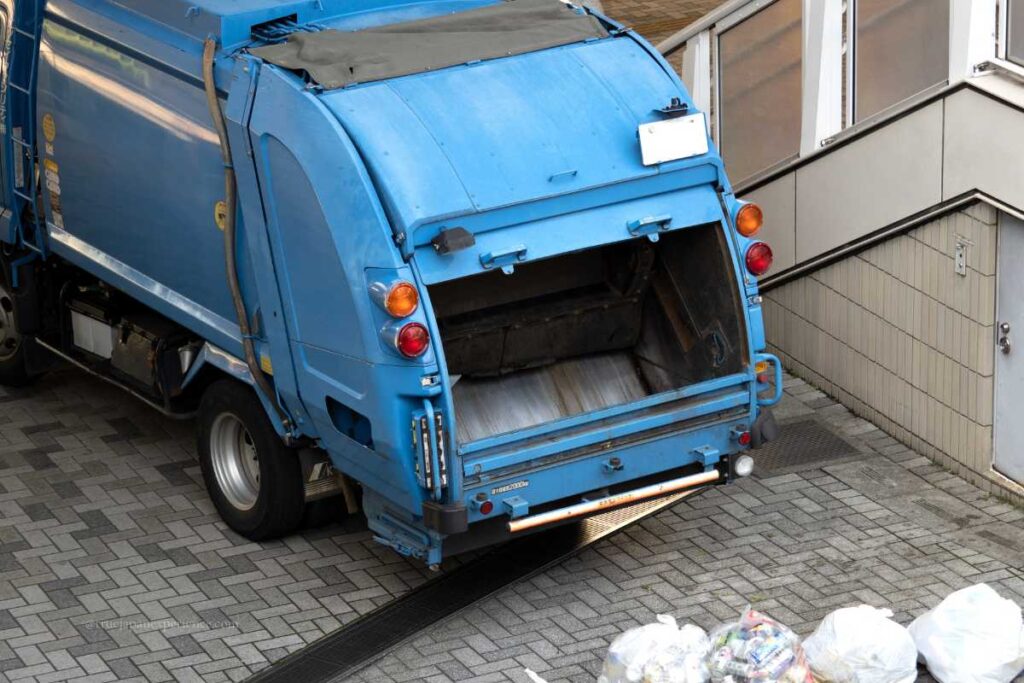
Garbage collection in Japan is frequent and highly organized.
Sorting Rules and Local Variations
apan’s garbage disposal system is famously strict — and incredibly detailed. One of the most confusing aspects is that each city, town, or ward has its own set of rules. This means the categories for sorting trash and the pickup schedules can vary widely, even between neighboring areas.
In general, trash is separated into at least the following categories:
・Burnable waste (可燃ごみ) — food scraps, paper, dirty plastics
・Non-burnable waste (不燃ごみ) — metal, glass, ceramics
・Recyclables — PET bottles, cans, glass bottles, cardboard, paper cartons
・Plastic packaging (プラスチック) — items with the “プラ” mark
・Oversized waste (粗大ごみ) — furniture, appliances (usually require special pickup)
In some municipalities, the rules go even further, asking residents to separate magazines from newspapers, transparent PET bottles from colored plastic bottles, or even cut paper into certain sizes before bundling.
Frequency of Collection
Another uniquely Japanese feature is the frequency of garbage collection.
Unlike in many countries where all trash is picked up once a week, Japan typically has:
Some neighborhoods also have volunteer-run recycling collection days, such as for used clothes or cooking oil, about twice a month.
In many developed countries and regions around the world, garbage collection — including both general waste and recyclables — is often said to take place about once or twice a week.
By comparison, households in Japan typically have garbage collected on 4 to 5 days each week — a remarkably high frequency by global standards.
How Japanese Residents Have Adapted to Fewer Trash Cans
JJapan’s streets are often praised for their cleanliness — especially considering how few public trash cans are available.
But that doesn’t mean people enjoy carrying their trash or always planned to do so.
In reality, the habit of taking trash home gradually developed after public bins were removed following the Tokyo subway sarin attack in 1995.
Since then, people in Japan have adapted.
The idea of holding onto your trash and taking it home became part of daily life — not because people wanted it that way, but because they had to find a way to manage.
Many now carry small plastic bags or wait until they get home to throw things away.
It’s become normal, simply because that’s how things have been for decades.
Of course, that doesn’t mean it’s convenient.
A lot of people feel that trash sorting is too complicated, that having to buy specific garbage bags is a hassle, and that there just aren’t enough public bins.
Still, many continue to follow the rules — not because it’s enjoyable, but because they feel it helps keep the city clean and comfortable for everyone.
Not everything works perfectly.
There are areas where sorting isn’t followed well, and sometimes sanitation workers face difficulties when dangerous items are mixed in.
So while the overall system functions, it would be wrong to assume that everyone always follows the rules, or that it’s easy.
Still, looking at how clean many streets remain, it does seem that people have found ways to live with the inconvenience.
It may not be ideal, but it works — and maybe that quiet effort, built into daily routines, is one reason why the cities stay as clean as they do.
Throwing Away Trash at Hotels in Japan
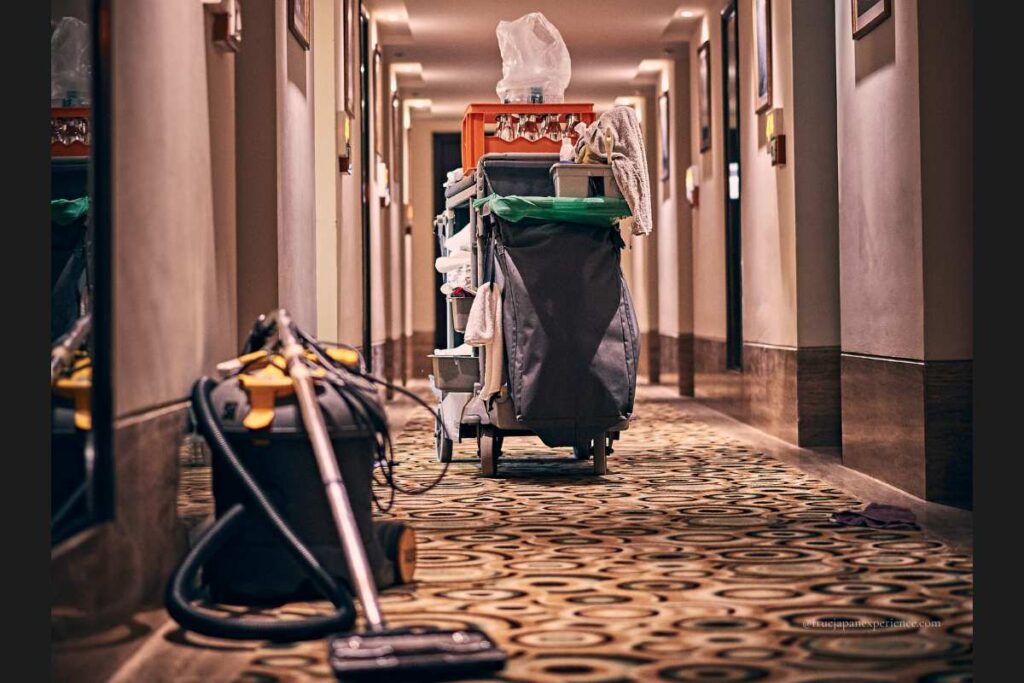
If you’ve ever stayed at a hotel in Japan, you may have wondered:
“There’s barely any trash space — what am I supposed to do with all this?”
Don’t worry. Trash handling in Japanese hotels is a bit different, but once you know the basics, it’s easy to deal with.
Small Trash Cans Are the Norm
Most hotel rooms in Japan come with only one small trash can, and it’s usually not separated for recyclables or categories.
Guests are generally not expected to sort their waste — hotel staff will handle it behind the scenes after collection.
If the room has multiple bins or special sorting instructions, follow the signage provided.
Some long-stay or eco-friendly hotels may also place separate bins in the hallway or common areas, especially for recyclables like bottles and cans.
Still, most city and business hotels use a simple one-bin system, and sorting is done later by staff.
When Trash Doesn’t Fit: What Not to Do
Hotel trash cans are small, and it’s easy for them to overflow after a meal or multi-day stay.
But certain actions can make things harder for the cleaning staff:
・Leaving trash on the desk or floor may be mistaken for a forgotten item
・Throwing away half-full bottles or cans can cause leaks or bad smells
・Placing uncovered food waste directly into the bin attracts insects and odor
How to Handle Excess Trash Properly
If you have more trash than the bin can hold:
・Put the excess trash in a separate bag
・Attach a note that says something like “Trash,” “Please throw away,” or “Please dispose of this,” and place it on top of the bag so it’s clearly marked.
・Place the bag neatly next to the trash can — not on the desk or elsewhere
・Wrap or tie up any food waste to help prevent smells and pests
It’s important to clearly mark that it’s trash.
Simply leaving a bag near the trash can is not enough.
Hotel staff cannot throw something away unless it’s obviously garbage.
Even something like a half-finished drink may be considered a forgotten item and stored as lost property.
To avoid confusion, always label your trash clearly to help the staff know it’s okay to dispose of it.
Types of Trash Bins in Public Spaces
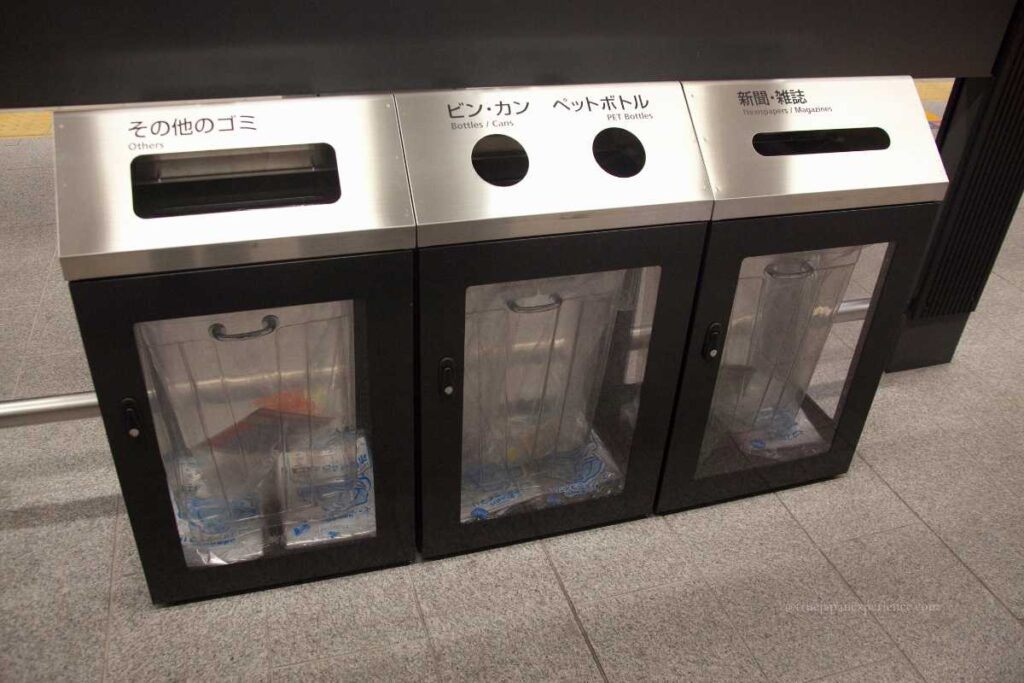
Even in stations, waste separation is expected.
While rare, public trash bins do exist — especially near:
These bins are usually separated into:
・Burnable waste
・PET bottles
・Cans and glass bottles
Illustrations or pictograms help indicate the right category, even for non-Japanese speakers.
Note: If a bin doesn’t specify categories, it’s generally okay to throw mixed trash.
Using Convenience Store Trash Bins: What to Know
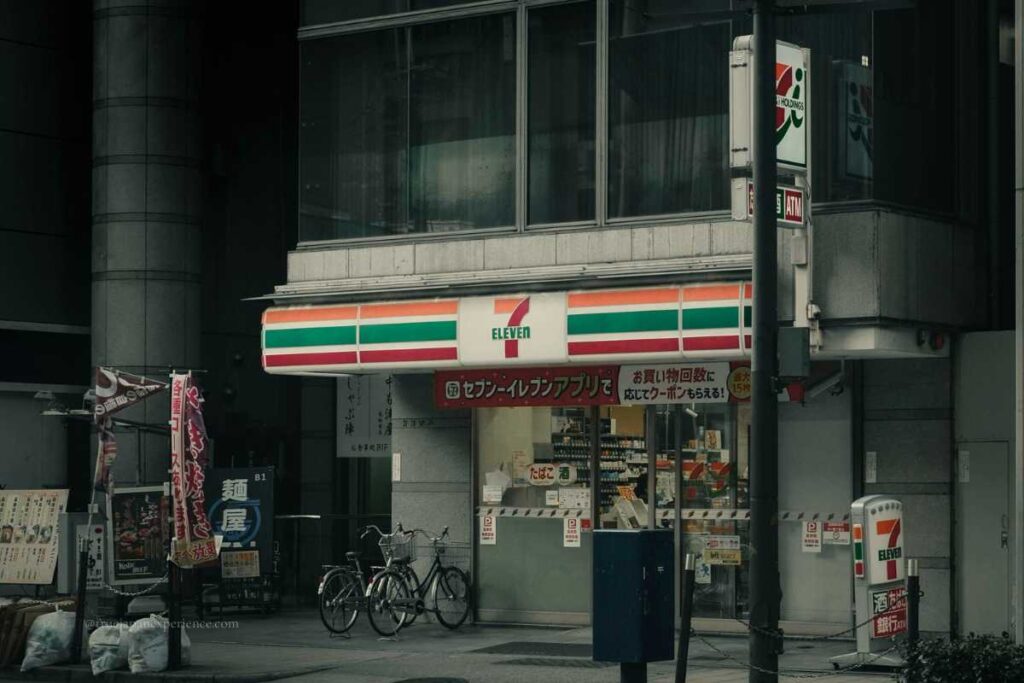
Many convenience stores in Japan do not provide outdoor trash bins.
In Japan, many convenience stores provide trash bins inside or just outside the store.
However, these bins are intended only for disposing of items purchased and consumed at that store — like bento boxes, drinks, or snacks.
Throwing away personal garbage, trash from other locations, or leftover packaging you brought from elsewhere is considered bad manners.
Many stores even post signs politely asking customers not to dispose of unrelated items.
If you bought something from the store and consumed it on the spot — such as at an in-store eating space or just outside — feel free to use the bins provided.
Be sure to follow the sorting labels on the bins — they often have separate sections for things like burnable waste, plastic bottles, or cans.
What to Do When You Can’t Find a Trash Can
In Japan, trash cans can be surprisingly hard to find — even in busy areas or tourist spots.
Because of this, it’s a good idea to carry a small plastic bag with you so you can hold onto your trash until you find a proper place to dispose of it.
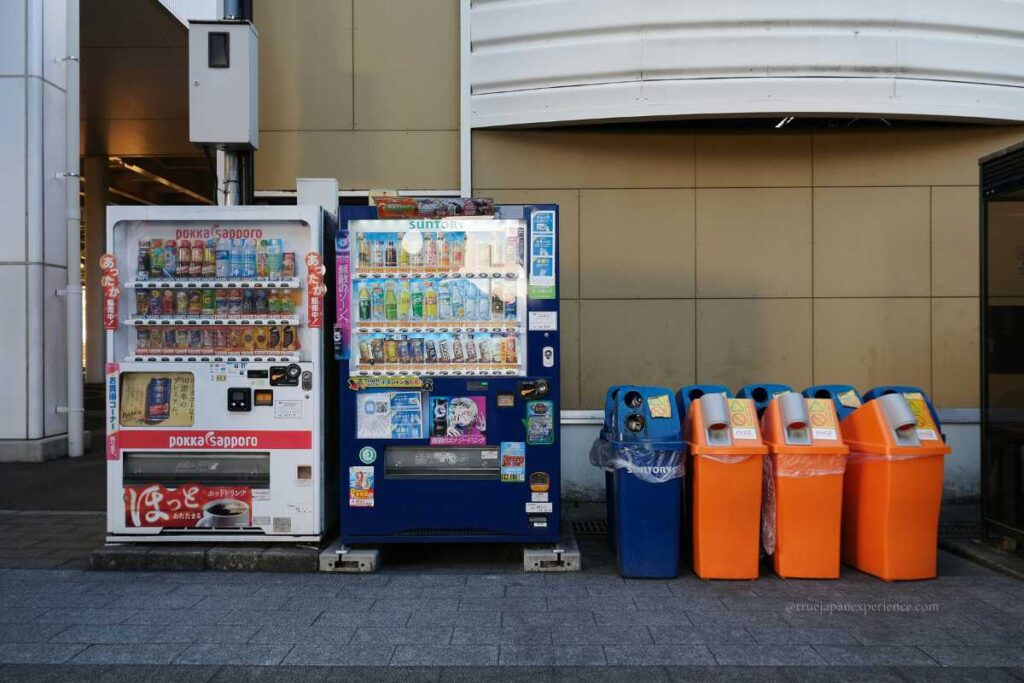
Vending machine trash bins are for bottles and cans only — other types of trash should not be thrown in.
That said, there are a few places where trash bins are more commonly available:
・Near station ticket gates or platforms
・Inside food courts or rest areas of shopping malls
・Designated rest spaces in parks or tourist centers
If you’re eating on the go or at a tourist spot, it’s often okay to ask the shop where you bought the item if you can throw away the packaging there.
Many vendors will kindly accept it if you ask politely.
During festivals or local events, temporary bins may be set up, but they can get full quickly.
If that’s the case, it’s best to take your trash with you and dispose of it later at your hotel.
And of course, never litter.
To help keep Japan’s streets clean and protect the environment, always throw trash away in the right place — even if that means carrying it for a while.
Final Tips for Responsible Travelers
Japan’s approach to waste might feel a little different at first — fewer trash cans, detailed sorting, and unspoken rules.
But don’t worry ー As long as you don’t litter or cause trouble for others, no one will expect you to know every rule.
If you make a small mistake with sorting, people won’t get angry.
It’s just about showing a little care and consideration — that’s more than enough.
You’re only here for a short time, and matching the culture — even just a little — can make the experience more meaningful.
So don’t stress too much.
And most importantly — enjoy your trip!
If you’re curious about other public rules in Japan, check out our guide to Smoking in Japan: Rules, Designated Areas, and What Tourists Need to Know.
Understanding where you can and can’t smoke is just as important as knowing where to throw away your trash — and it’ll help you avoid uncomfortable situations during your trip.










